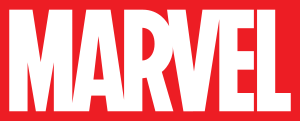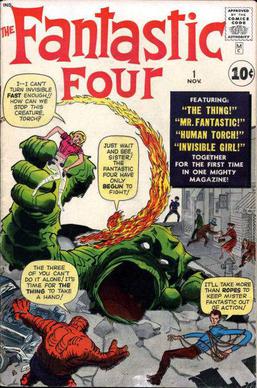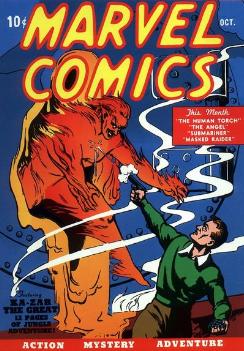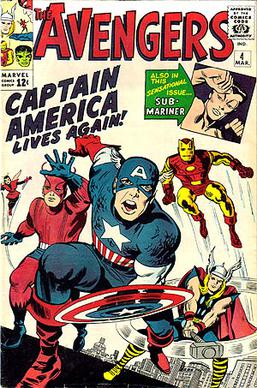Marvel Comics facts for kids
 |
|
| Parent company | Marvel Entertainment, LLC (The Walt Disney Company) |
|---|---|
| Status | Active |
| Founded | 1939 (as Timely Comics) 1947 (as Magazine Management) 1961 (as Marvel Comics) |
| Founder | Martin Goodman |
| Country of origin | United States |
| Headquarters location | 135 W. 50th Street, New York City |
| Distribution | Diamond Comic Distributors Hachette Client Services |
| Key people |
|
| Publication types | Comics/See List of Marvel Comics publications |
| Fiction genres |
|
Marvel Comics is a famous American company that makes comic books. It started in 1939 as Timely Comics. Marvel is best known for its many superhero characters. Its main rival is DC Comics. In 2009, The Walt Disney Company bought Marvel. Many of Marvel's popular characters were created by Stan Lee, Jack Kirby, Steve Ditko, and other talented people.
Contents
The Start of Marvel Comics
Marvel Comics has changed its name a few times. It was first called Timely Comics in the 1940s. Then, in the 1950s, it became Atlas Comics. The first comic book released under the name "Marvel Comics" was The Fantastic Four #1 in November 1961.
The company was started in 1939 by a publisher named Martin Goodman. He wanted to create comic books because they were becoming very popular. Timely Comics' first comic was Marvel Comics #1 in October 1939. This comic featured early superheroes like the Human Torch and the Sub-Mariner.
During the 1940s, which is called the "Golden Age" of comics, Timely Comics introduced many superheroes. One of the most important was Captain America, who first appeared in Captain America Comics #1 in March 1941. These early characters often fought against the Nazis and the Japanese in their stories.
As the 1940s ended, superheroes became less popular. Timely Comics stopped publishing superhero books in 1950. In 1951, the company changed its name to Atlas Magazines. Atlas mostly published comics about humor, westerns, horror, war, and science fiction. They tried bringing back superheroes like Captain America in 1953, but it didn't last long.
In 1956, another company, DC Comics, brought back superheroes. This started the "Silver Age" of comics. In the early 1960s, Atlas changed its name again to Marvel Comics. For many years, Marvel and DC were the two biggest comic book companies.
Marvel faced some tough times in the 1980s and 90s. The company went through changes in ownership and had some financial problems. But Marvel recovered and started making different kinds of comics. They also began making movies through Marvel Studios. In 2007, Marvel started publishing digital comics. In 2009, The Walt Disney Company bought Marvel.

In 1961, Marvel created a special way for all its characters to live in the same world. This is known as the Marvel Universe. It started when Martin Goodman asked writer Stan Lee and artist Jack Kirby to create the Fantastic Four.
When Fantastic Four #1 came out in November 1961, readers saw a superhero world that felt real. Stan Lee and Jack Kirby made their characters act like real people. They would argue or even fight each other sometimes. This made the comics feel more exciting and new.
Many other superheroes soon joined the Marvel Universe in the early 1960s. These included Spider-Man, the Incredible Hulk, and the X-Men. Stan Lee wrote most of these stories. Jack Kirby and Steve Ditko were the most important artists.
This realistic way of showing characters made Marvel very popular. Even college students started reading their comics. The stories also began to talk about real-world issues like pollution and how people get along.
Later, new writers and artists joined Marvel. In the late 1960s, Jim Steranko created exciting stories about secret agent Nick Fury. In 1975, writer Chris Claremont and artist John Byrne worked together on The Uncanny X-Men. They made the X-Men very popular with new characters like Wolverine and complex stories.
In the 1980s, Frank Miller made Daredevil comics darker and more serious. This helped the comic sell much better. Todd MacFarlane became a very popular artist for The Amazing Spider-Man in 1988. Some artists, including Todd MacFarlane, later left Marvel to start their own company called Image Comics.
In the 1990s and 2000s, new writers like Brian Michael Bendis and Ed Brubaker created more grown-up stories for Marvel's characters. More recently, in the 2010s, writers like Matt Fraction and G. Willow Wilson created popular comics like Hawkeye and Ms. Marvel.
In the 2000s, Marvel started making a lot of money from toys, video games, and movies. These movies were special because they all took place in the same shared world, just like the comics. This big plan worked very well. The Avengers movie in 2012 brought together heroes like Iron Man, Thor, and Captain America. It earned over $1.5 billion worldwide!
This shared movie world is called the Marvel Cinematic Universe (MCU). It became one of the most successful movie series ever. Its success also led to many TV shows, like Agents of S.H.I.E.L.D. and shows on Netflix like Daredevil. In 2015, Spider-Man, who used to only appear in movies made by Sony, joined the MCU. Marvel Studios continued to make hit movies, even with less famous heroes like the Guardians of the Galaxy and Doctor Strange. By 2016, the MCU movies had earned over $10 billion around the world.
Marvel's Adaptations
Marvel's characters have become even more popular through movies, toys, video games, cartoons, and other products.
Famous Marvel Characters
Superheroes
Marvel is known for creating many iconic and well-known superheroes:
- Spider-Man
- Namor the Sub-Mariner
- Captain America
- Deadpool
- Hércules
- The Incredible Hulk
- Hawkeye
- Falcon
- Ms. Marvel
- Scarlet Witch
- Wolverine
- She-Hulk
- Thor
- Ant-Man
- Iron Man
- War Machine
- Ghost Rider
- Black Panther
- Black Widow
- Captain Marvel
- Doctor Strange
- Howard the Duck
- Jessica Jones
- Nick Fury
- Silver Surfer
- The Punisher
- Blade
- Daredevil
- Elektra
- Vision
- Star-Lord
- Drax
- Groot
- Mantis
- Rocket Racoon
- Emma Frost
Superhero Teams
Most Marvel characters live in the fictional Marvel Universe. This universe has places that look like real cities and also made-up locations. Some of their most famous superhero teams are:
- The Avengers
- The Fantastic Four
- The Inhumans
- The Defenders
- The Runaways
- Guardians of the Galaxy
- S.H.I.E.L.D.
- X-Men
Supervillains
The company is also famous for creating some of the most well-known villains:
- Doctor Doom
- Doctor Octopus
- Venom
- Sandman
- Lizard
- Electro
- Galactus
- Thanos
- Rhino
- Mysterio
- Mephisto
- Blackheart
- Blackout
- Kang the Conqueror
- Mystique
- Apocalypse
- Ultron
- Red Hulk
- Kraven the Hunter
- Green Goblin
- Red Skull
- Magneto
- Loki
Supervillain Teams
Marvel is also known for some of the most iconic supervillain teams:
- The Dark Avengers
- The Frightful Four
- Masters of Evil
- Sinister Six
- H.A.M.M.E.R.
- The Dark X-Men
- Thunderbolts
- Black Order
Marvel's Offices
Marvel's main offices have always been in New York City. Over the years, they have moved to different buildings, including:
- The McGraw-Hill Building, where Timely Comics started in 1939.
- The Empire State Building.
- Various locations on Madison Avenue.
- 135 W. 50th Street, their current large office space.
Images for kids
-
Howard the Duck #8 (January 1977).
See also
 In Spanish: Marvel Comics para niños
In Spanish: Marvel Comics para niños







